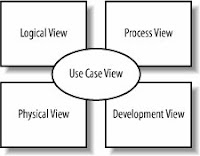 Russ Miles & Kim Hamilton
Russ Miles & Kim HamiltonISBN: 978-0596009823
I have never been a big fan of UML or really seen the need for it. However I was told it was imperative for my latest contract, so I out my old copy of UML distilled by Martin Fowler and bought a new copy of it for my Kindle and started reading it. I had been with my new client very long when someone recommended Learning UML 2.0 by Russ Miles and Kim Hamilton. It contains the Philippe Kruchten 4+1 model that we would be using for the project so I thought it would probably make a better book to learn from (no pun intended).

Philippe Kruchten 4+1 Model
This is a great book. Easy to read and lots of detail about the key areas of UML 2.0. It doesn't cover absolutely everything, but recommends other books that do. There are lots of code examples in Java. I'm not sure if all of these are useful or if the authors, who are programmers, were just desperate to get some code in.
The book focuses on what in my opinion are the most useful diagrams:
- Use Cases
- Activity Diagrams
- Class Diagrams
- Object Diagrams
- Sequence Diagrams
- Communication Diagrams
- Timing Diagrams
- Interaction Overview Diagrams
- Composite Structures
- Component Diagrams
- State Machine Diagrams
- Deployment Diagrams
In my opinion if you want to learn the important parts of UML in a hurry. This is the book for you.

Comments
Post a Comment